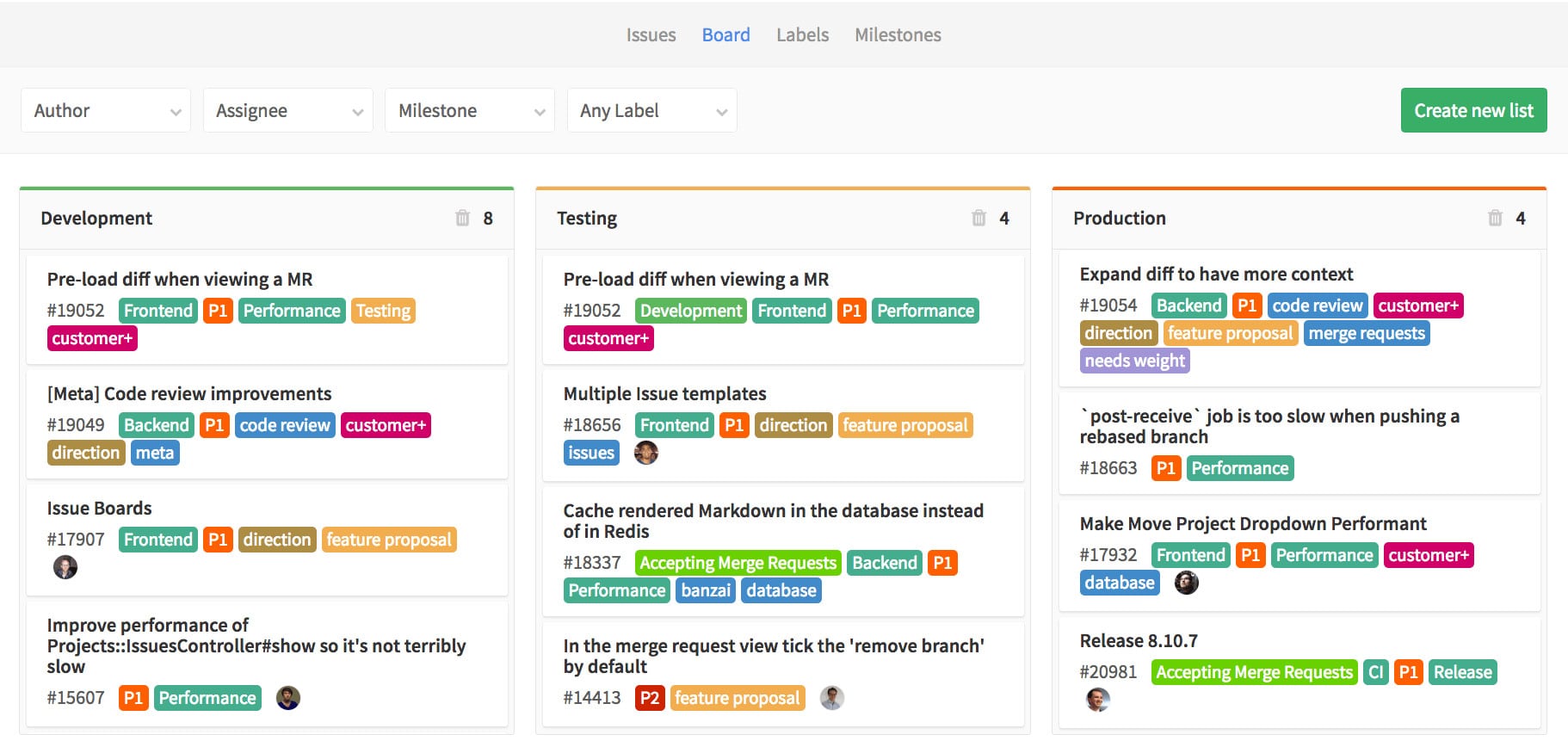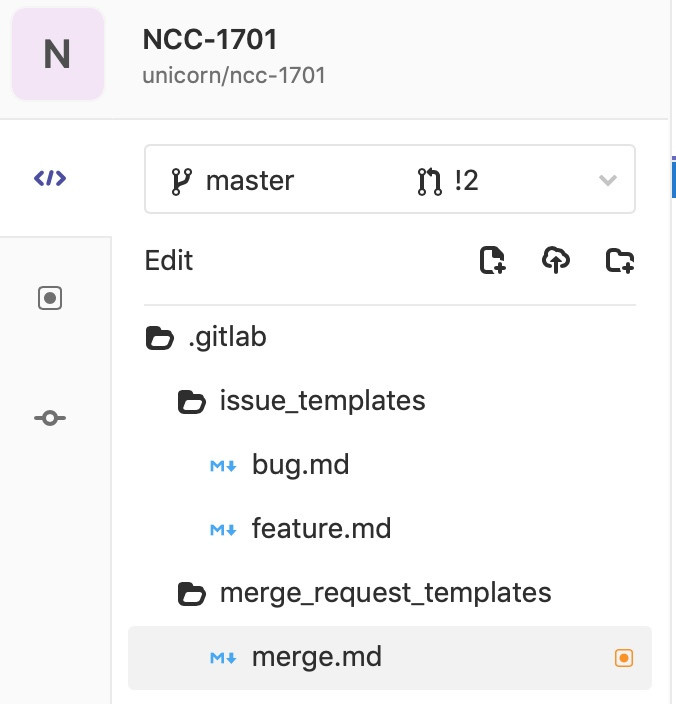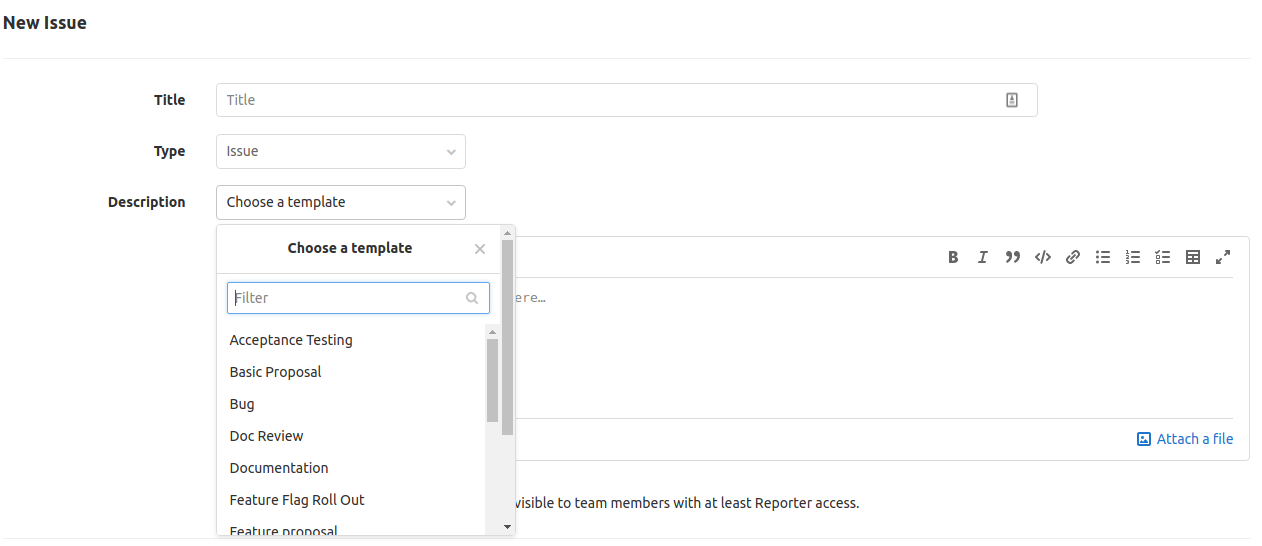Gitlab Issue Templates
Gitlab Issue Templates - When bulk editing issues in a project, you can edit the following attributes: Create a template in the.gitlab/issue_templates folder (you may need to create the folder first) and, once it is on your default branch, it will be available when creating new issues. 13 languages are supported, including javascript, python, go, java, and kotlin. To create an issue description template: Web you can create default issue templates and a default configuration file for issue templates for your organization or personal account. Some default labels are set as an example. Web 1 answer sorted by: For more information, see creating a default community health file. creating issue templates on github.com, navigate to the main page of the repository. By using appropriate templates, adding labels, and adding relevant information in descriptions and comments, the team can communicate which issues affect customers along with their priority and severity. Update 2022, for all gitlab tier:
Web select plan > issues. Feel free to download this package, unpack it in your repository and adapt the templates to your needs. See gitlab 14.8 (february 2022) Issue templates are written in markdown. Web 1 answer sorted by: Next to the default branch, select. Some default labels are set as an example. Issues enable and support discussions on images and designs with design management. Web create an issue template create a new markdown (.md) file inside the.gitlab/issue_templates/ directory in your repository. To create an issue description template:
Edit or remove them according to your project settings. Learn how to create an issue template. From the dropdown list, select your template project as the template repository at group level. On the left sidebar, at the top, select search gitlab () to find your project. Some default labels are set as an example. On the top bar, select menu > groups and find your group. Select the checkboxes next to each issue you want to edit. Feel free to download this package, unpack it in your repository and adapt the templates to your needs. When bulk editing issues in a project, you can edit the following attributes: Update 2022, for all gitlab tier:
GitLab develops project management tool Issue Board to counter GitHub
Web 1 answer sorted by: When bulk editing issues in a project, you can edit the following attributes: On the top bar, select menu > groups and find your group. On the left sidebar, at the top, select search gitlab () to find your project. Feel free to download this package, unpack it in your repository and adapt the templates.
GitLab Issue Templates Save time and standardise issue reports
Web select plan > issues. Seems like you can archive this through gitlab project templates for groups: Feel free to download this package, unpack it in your repository and adapt the templates to your needs. Be used for any new repository include your standard issue template file be pushed to your new gitlab repo. Issue templates are written in markdown.
StepbyStep Guide to Creating Issue Templates in GitLab by Ee Leng
On the top bar, select menu > groups and find your group. Status (open or closed) assignees From the sidebar, edit the available fields. Edit or remove them according to your project settings. By using appropriate templates, adding labels, and adding relevant information in descriptions and comments, the team can communicate which issues affect customers along with their priority and.
GitLab Issue Templates & Merge Request Templates iT 邦幫忙一起幫忙解決難題,拯救
The notion of template repository is only for gitlab premium. See gitlab 14.8 (february 2022) For more information, see creating a default community health file. creating issue templates on github.com, navigate to the main page of the repository. Next to the default branch, select. Learn how to create an issue template.
StepbyStep Guide to Creating Issue Templates in GitLab by Ee Leng
Web create an issue template create a new markdown (.md) file inside the.gitlab/issue_templates/ directory in your repository. Next to the default branch, select. See gitlab 14.8 (february 2022) From the dropdown list, select your template project as the template repository at group level. Web creating issue templates.
StepbyStep Guide to Creating Issue Templates in GitLab by Ee Leng
├──.gitlab │ └── issue_templates │ ├── feature.md │ └── bug.md. On the left sidebar, select settings > general. Edit or remove them according to your project settings. Some default labels are set as an example. They exist as.md files within your project repository.
GitLab Issue Templates Save time and standardise issue reports
Status (open or closed) assignees In each project, a set of issue templates can be defined to make it easy to create common issues for different situations or problems. From the dropdown list, select your template project as the template repository at group level. Under your repository name, click settings. Create a template in the.gitlab/issue_templates folder (you may need to.
Issue Templates DEV Community
Edit or remove them according to your project settings. On the left sidebar, select settings > general. Web 1 answer sorted by: Learn how to create an issue template. Update 2022, for all gitlab tier:
GitLab Solution Agile Planning with GitLab ESPIN Group
For more information, see creating a default community health file. creating issue templates on github.com, navigate to the main page of the repository. They exist as.md files within your project repository. Issue templates are written in markdown. Be used for any new repository include your standard issue template file be pushed to your new gitlab repo. Issues enable and support.
StepbyStep Guide to Creating Issue Templates in GitLab by Ee Leng
In each project, a set of issue templates can be defined to make it easy to create common issues for different situations or problems. Web you can create default issue templates and a default configuration file for issue templates for your organization or personal account. 13 languages are supported, including javascript, python, go, java, and kotlin. Web creating issue templates..
On The Left Sidebar, Select Settings > General.
When bulk editing issues in a project, you can edit the following attributes: Update 2022, for all gitlab tier: Web you can create default issue templates and a default configuration file for issue templates for your organization or personal account. Learn how to create an issue template.
Status (Open Or Closed) Assignees
Under your repository name, click settings. For more information, see creating a default community health file. creating issue templates on github.com, navigate to the main page of the repository. Web gitlab ci/cd is a devops automation tool that helps software developers automate the steps involved in building, testing, and deploying code, as well as improving productivity, security, and. From the sidebar, edit the available fields.
Web You Can Find Some Super Useful Templates Here:
See gitlab 14.8 (february 2022) To create an issue description template: Web create an issue template create a new markdown (.md) file inside the.gitlab/issue_templates/ directory in your repository. Edit or remove them according to your project settings.
Web 1 Answer Sorted By:
Seems like you can archive this through gitlab project templates for groups: They exist as.md files within your project repository. From the dropdown list, select your template project as the template repository at group level. On the top bar, select menu > groups and find your group.









